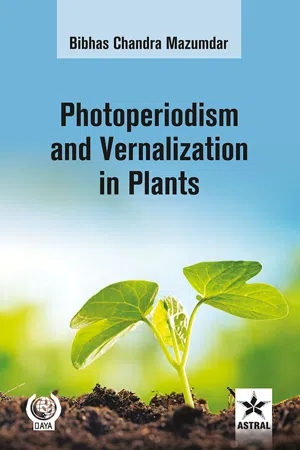
This is a test
- English
- PDF
- Available on iOS & Android
eBook - PDF
Photoperiodism & Vernalization in Plants
Book details
Table of contents
Citations
About This Book
Photoperiodism and vernalization are fascinating areas in plant physiology. The phenomena were conceived as the expedients to switch on flowering in plants but with passage of time, divulged intricacies establishing as exponents to a wider range of functional processes in them. Despite much of the complexities on the living processes in plants have been discovered by delving into these areas, much remains to be unravelled. The present title has brought forward the diverse features of these disciplines to the students and buding scientists of plant physiology in a simplified form to arouse their interest and gain ground for deeper understanding into these spheres.
Frequently asked questions
At the moment all of our mobile-responsive ePub books are available to download via the app. Most of our PDFs are also available to download and we're working on making the final remaining ones downloadable now. Learn more here.
Both plans give you full access to the library and all of Perlego’s features. The only differences are the price and subscription period: With the annual plan you’ll save around 30% compared to 12 months on the monthly plan.
We are an online textbook subscription service, where you can get access to an entire online library for less than the price of a single book per month. With over 1 million books across 1000+ topics, we’ve got you covered! Learn more here.
Look out for the read-aloud symbol on your next book to see if you can listen to it. The read-aloud tool reads text aloud for you, highlighting the text as it is being read. You can pause it, speed it up and slow it down. Learn more here.
Yes, you can access Photoperiodism & Vernalization in Plants by Mazumdar, Bibhas Chandra in PDF and/or ePUB format, as well as other popular books in Biological Sciences & Horticulture. We have over one million books available in our catalogue for you to explore.
Information
Table of contents
- Preface
- PART I: PHOTOPERIODISM
- 1. Physical Aspects of Light and its Role in Plants
- 1.1.1 Physical aspects of light
- (1) Light as energy
- (2) Dispersion of light
- (3) Quality of light
- (4) Quantity of light
- 1.1.2 How light affects plants
- 2. Photoperiodism
- 1.2.1 Historical aspect
- 1.2.2 Definition and concept
- 1.2.3 Photoperiodic groups of plants
- (1) Photoperiodic groups made by Garner and Allard
- (2) Critical photoperiod
- (3) Quantitative and qualitative responses
- (4) Interaction of other factors
- (5) Photoperiodic groups and sub-groups made after Garner and Allard
- 1.2.4 Maturity of plants for photoperiodic responses
- 1.2.5 Requirement of the number of photo-inductive cycles
- 1.2.6 Photoperiodic induction
- 1.2.7 Site of perception of photoperiodic stimulus
- 1.2.8 Role of dark and light periods in photoperiodic cycles
- (1) Role of dark period
- (2) Role of light period
- 1.2.9 Role of light quality and phytochrome
- (1) Light quality (wavelength)
- (2) Phytochrome
- 1.2.10 Time measurement by plants
- 1.2.11 Mechanism of photoperiodism
- 1.2.12 Genetic approach of photoperiodic response in plants
- 1.2.13 Photoperiodic effects other than flowering
- 1.2.14 Practical utilization of photoperiodism
- 1.2.15 Review of terminology
- PART II: VERNALIZATION
- 1. Physical Aspects of Heat and its Role in Plants
- 2.1.1 Physical aspects of heat
- (1) Heat as energy
- (2) Temperature
- (3) Difference between heat and temperature
- (4) Transmission of heat
- 2.1.2 How heat affects plants
- 2. Vernalization
- 2.2.1 Historical aspect
- 2.2.2 Definition and concept
- 2.2.3 Quantitative and qualitative responses
- 2.2.4 Examples of vernalizable seeds and plants
- 2.2.5 Site of perception of vernalization stimulus
- (1) Seed
- (2) Shoot apex
- (3) Other plant parts
- 2.2.6 Maturity factor in vernalization
- (1) Required maturity
- (2) Internal changes during maturity period
- 2.2.7 Technique of vernalization of seeds and other plant parts
- 2.2.8 Induction of vernalization effect
- 2.2.9 Reversibility of vernalization response
- (1) Devernalizing agents
- (2) Stage of high temperature-induced devernalization
- (3) Change in physiological condition
- (4) Arresting devernalization
- (5) Revernalization
- 2.2.10 Mechanism of vernalization
- (1) Energy-requiring process
- (2) Higher metabolic activity
- (3) Synthesis of active substance and its hormonal nature
- (4) Involvement of gibberellins
- (5) Involvement of auxins
- (6) Formation of protein
- (7) Involvement of nucleic acids
- 2.2.11 Genetic approach of vernalization
- 2.2.12 Practical utilization of vernalization
- 2.2.13 Relationship between vernalization and photoperiodism
- Bibliography
- Index